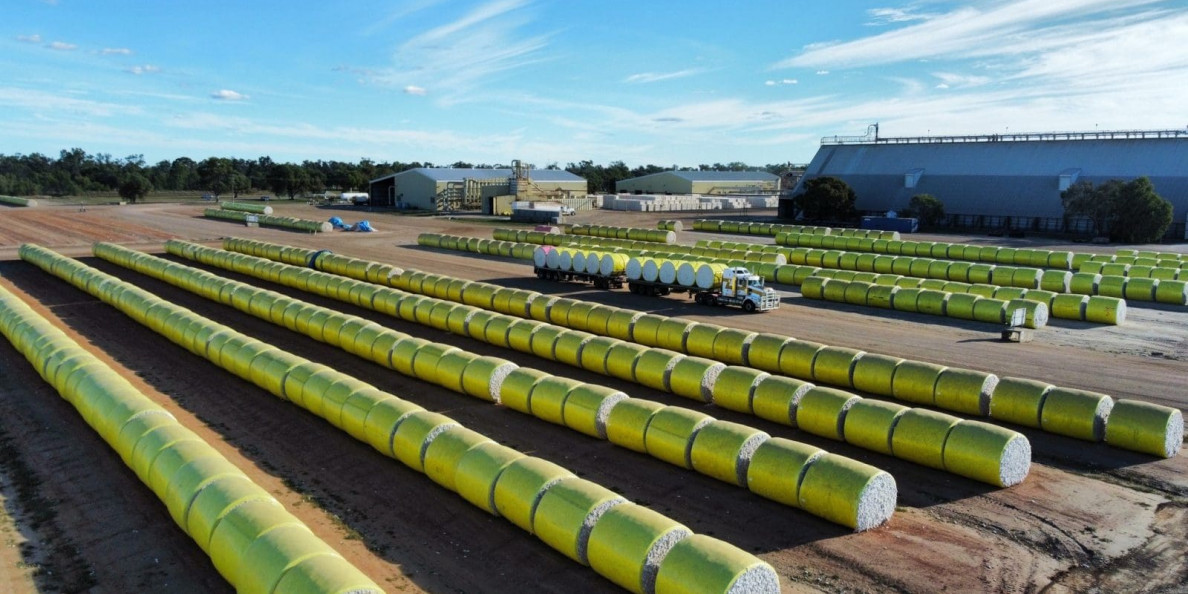Emma Alsop
ALMOST 90 percent of Australia’s 2023-24 cotton has been ginned and classed, with the 5.5-million-bale crop outperforming most years in grade and colour.
Despite a slower start, exports to China are increasing, with Vietnam still remaining Australia’s main market.
Australian Cotton Shippers Association and Cotton Australia board member Arthur Spellson said the 2023 ginning season was a welcome change compared to the previous year, which was impacted by prolonged flooding and rainfall.
Mr Spellson said crops in most growing regions benefited from the drier and warmer end to the season.
He said north from Warren in the Macquarie Valley of New South Wales, quality has been excellent, but this had not been replicated in the southern valleys.
“They had some significant challenges down in the Murrumbidgee,” Mr Spellson said.
“They had trouble getting it planted and then had a cool season.
“They had a lot of their cotton discounted for low micronaire because the fibre just wasn’t fully mature.”
Although, quality results are yet to be finalised, Mr Spellson said overall the grade across Queensland and NSW was anticipated to be near record, second only to the 2018 crop.
“From a grade perspective, colour and leaf, it has been very good and that flows through into length and strength.”
He said due to the favourable conditions, the crop required little cleaning during the ginning process.
“When they do minimal cleaning, it makes really nice cotton.”
Border Rivers lead way
Following a perfect finish, quality and volumes into southern Qld gins have exceeded expectations.
Namoi Cotton account manager Jock Jackson said Border Rivers and south-west Qld saw record volumes and yields.
“The cotton yielded really well and the turn-outs have been a lot higher than the previous season,” Mr Jackson said.
“Western Queensland is where you saw the highest yields.”
Mr Jackson said both Namoi’s MacIntyre and Mungindi sites have broken ginning records by about 20,000 bales.
“It was perfect conditions…which made it a big year for us.”
He said the sites were expected to finish ginning next month.
Most gins have finished operating for the season; however, the Darling Downs, Cubbie Station and Emerald facilities will continue processing, and the last closure is expected in December.
Exports keep pace
These larger volumes from Qld, along with the later-than-normal crop, combined to slow the pace of early cotton exports.
Volumes increased from June onwards with the industry expected to export 6.16M bales in 2022-23, according to the September USDA Cotton: World Markets and Trade report.
ACSA director and S&G Cotton Australia representative Roger Tomkins said the industry was concerned that the amount of static storage space could not keep up with demand in some regions, particularly southern Qld.
“We are over the hurdle and we are now seeing more bales move out of warehouses than move in from earlier this month,” Mr Tomkins said.
“We have got there, not to say that it hasn’t been tight in some locations.”
Mr Spellson said Vietnam was still Australia’s strongest export market, followed by India, Indonesia, China, Bangladesh and Turkey.
“We have put a lot of effort into diversifying our markets.
“People love our cotton; it is just about when the price is right it will find a home.”
Mr Spellson said China has returned as a key destination for Australian cotton.
According to WASDE figures, Australia exported 20,000 tonnes to China in June, which was the largest single monthly volume since the end of 2019.
“It is not open slather; it is very piecemeal, but we are back to having reasonable volumes go to China which is good.”
Mr Tomkins said while it was pleasing to see more Australian cotton enter China, “it will never regain the size that it had prior to the soft ban”.
“Despite this, China is still an important market…and a large market that cannot be dismissed.”
Above-average 2024
With planting set to commence in most regions in the coming months, growers are finalising preparations for the upcoming season.
The Australian cotton industry is currently predicting the 2024 crop to be about 4Mb.
Although this is a significant drop from the 5.5Mb achieved this year, the crop will still be above average for the industry.
“The reduction comes from the forecast for a lot less dryland,” Mr Spellson said.
“We then have some areas like the Murrumbidgee and Macquarie that will grow more than what they did this year.”
Mr Spellson said irrigated cotton growers would not be too concerned at this stage about the recent El Niño declaration.
“We have got water in storage, so we are better off than other crops.
“When things turn dry it takes a bit longer for the irrigators to feel the impact.”
However, Mr Spellson said some irrigators may opt to reduce water usage to conserve volumes for future seasons if the El Niño conditions look set to continue into 2025.
Cotton Australia Southern NSW regional manager Tom Mannes said growers in the southern valleys began planting last week.
“The weather looks favourable and it is looking like a sizeable crop,” Mr Mannes said.
He said it is estimated that about 75,000ha of cotton will be planted in the Murray, Murrumbidgee and Lachlan Valleys.
Mr Tomkins said a larger crop in southern valleys will reduce the pressure on Queensland exporters experienced this year.
“It is going to be easier on the Australian domestic front because the crop is going to be spread more evenly across the southern and central valleys.
“This year we were very concentrated with our volumes in Brisbane.
“It is expected to change with the 2024 crop.”
